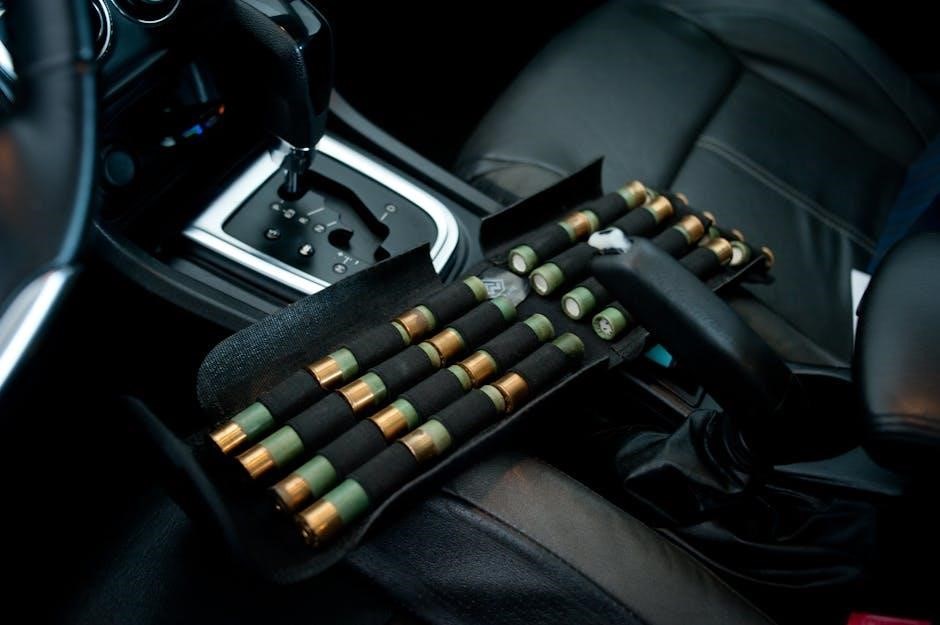A stuck manual transmission can leave you stranded, posing safety risks and causing frustration. Understanding its causes, such as low fluid levels or damaged components, is crucial for timely fixes and preventing costly repairs or accidents.
What is the Issue?
A stuck manual transmission occurs when the gearbox fails to shift gears, leaving the vehicle in a fixed gear. This issue arises from problems like low transmission fluid, damaged shifter cables, or internal component wear. If not addressed, it can lead to safety hazards and further damage, making prompt diagnosis and repair essential.
Importance of Addressing the Problem
Addressing a stuck manual transmission promptly is crucial to prevent further damage and ensure road safety. Ignoring the issue can lead to costly repairs, such as replacing internal components or the entire gearbox. Additionally, a malfunctioning transmission increases the risk of accidents, especially if the vehicle becomes unable to shift gears while driving. Regular maintenance, including checking transmission fluid levels and inspecting shifter components, can help prevent such issues. Acting quickly not only saves money but also ensures the vehicle operates smoothly and safely, reducing the risk of breakdowns and accidents.
Common Causes of a Stuck Manual Transmission
A stuck manual transmission often results from low transmission fluid levels, which disrupts lubrication, or damaged shifter cables/linkage, hindering proper gear engagement. These issues can lead to gears sticking and difficulty shifting, requiring prompt attention to avoid further damage.
Low Transmission Fluid Levels
Low transmission fluid levels are a common cause of a stuck manual transmission. Transmission fluid is essential for lubricating gears and ensuring smooth shifting. When fluid levels drop due to leaks, improper filling, or wear, friction increases, causing gears to stick or refuse to engage properly.
Symptoms of low fluid include difficulty shifting, grinding noises, and hesitation between gears. Over time, insufficient lubrication can lead to premature wear on gear teeth and synchronizers, exacerbating the issue. If left unaddressed, this can result in costly repairs.
Regular fluid checks are crucial to maintain optimal levels. Using a dipstick or consulting the owner’s manual can help determine the correct fluid level. Ensure the fluid is clean and of the recommended type, as improper fluid can worsen transmission performance.
Addressing low fluid levels promptly is vital to prevent further damage and ensure smooth gear operation. Always refer to the manufacturer’s guidelines for the correct fluid type and maintenance schedule to keep your manual transmission functioning effectively.
Damaged Shifter Cable or Linkage

A damaged shifter cable or linkage is another common cause of a stuck manual transmission. The shifter cable connects the gearshift to the transmission, translating your movements into gear changes. If the cable is damaged, frayed, or disconnected, it can prevent the transmission from shifting properly.
Signs of a faulty shifter cable include gears that feel stuck, difficulty engaging specific gears, or a loose and unresponsive shifter. Over time, wear and tear can cause the cable to lose tension or break entirely, leading to a loss of control over gear selection.
The linkage connecting the shifter to the transmission can also become misaligned or worn out, disrupting the mechanical connection needed for smooth shifting. Dirt, debris, or corrosion within the linkage can further exacerbate the issue, making it harder to shift gears.
Inspecting and replacing a damaged shifter cable or linkage is essential to restore proper transmission function. Regular maintenance, such as cleaning and lubricating the linkage, can help prevent these issues and ensure your manual transmission operates smoothly.

Symptoms of a Stuck Manual Transmission

- Difficulty Shifting Gears: Gears may feel stuck or unresponsive, making it hard to engage or disengage them smoothly.
- Grinding Noises: Unusual grinding sounds can occur when attempting to shift, indicating mechanical issues within the transmission.
Difficulty Shifting Gears
One of the most noticeable symptoms of a stuck manual transmission is difficulty shifting gears. This can manifest as a stubborn resistance when trying to engage or disengage gears, making it hard to transition smoothly between them. Drivers may find themselves struggling to move the gearshift into the desired position, even when the clutch is fully depressed. This issue can occur unexpectedly, leaving the vehicle stuck in a specific gear and unable to accelerate or decelerate properly. In some cases, the gears may feel “sticky” or unresponsive, requiring excessive force to shift. This problem is often linked to low transmission fluid levels, damaged shifter cables, or worn-out clutch plates. If left unaddressed, it can lead to further damage, such as grinding noises or complete gear engagement failure. Identifying the root cause is essential to restore smooth shifting and ensure safe operation of the vehicle. Early diagnosis can prevent more severe and costly repairs down the line.
Grinding Noises

Grinding noises are another common symptom of a stuck manual transmission and often indicate internal damage or misalignment within the gearbox. These noises typically occur when attempting to shift gears, as the gears fail to engage smoothly. The grinding sound is caused by metal components rubbing against each other improperly, which can lead to further wear and tear on the transmission. This issue is frequently linked to low transmission fluid levels, as insufficient lubrication prevents gears from shifting seamlessly. Additionally, worn-out synchronizers or damaged gear teeth can cause gears to clash, resulting in the grinding noise. If left unaddressed, this problem can escalate, leading to costly repairs or even complete transmission failure. It is crucial to investigate and resolve grinding noises promptly to avoid exacerbating the damage. Regular maintenance, such as checking fluid levels and inspecting internal components, can help prevent these issues from arising. Ignoring grinding noises may result in more severe complications, making it essential to address the problem early on.

Diagnosis Methods
Diagnosing a stuck manual transmission involves a systematic approach to identify the root cause. Start by checking the transmission fluid level, as low fluid or improper lubrication can lead to sticking gears. Use the dipstick or consult your vehicle’s manual for guidance. If fluid levels are adequate, inspect the shifter cable and linkage for damage or misalignment. These components are typically located under the car and can be visually examined for signs of wear or breakage.
Next, assess the internal components, such as synchronizers and gear teeth, for wear or damage. Listening for grinding noises during gear shifts can indicate internal issues. If symptoms persist, consider disconnecting the shift linkage and manually shifting gears to isolate the problem. This step can help determine if the issue lies within the transmission itself or with the external controls.
Additionally, test the clutch system to ensure it engages and disengages properly. A malfunctioning clutch can prevent the transmission from shifting smoothly. If internal damage is suspected, advanced diagnostic tools or professional inspection may be necessary. By methodically evaluating each potential cause, you can accurately diagnose and address the issue, preventing further damage and ensuring proper transmission function. Early detection is key to avoiding costly repairs.
